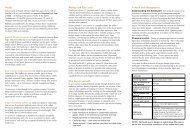Bushland Weeds Manual - Environmental Weeds Action Network
Bushland Weeds Manual - Environmental Weeds Action Network
Bushland Weeds Manual - Environmental Weeds Action Network
You also want an ePaper? Increase the reach of your titles
YUMPU automatically turns print PDFs into web optimized ePapers that Google loves.
12<br />
Chapter 3 Grass <strong>Weeds</strong><br />
Box 3.3 Grass growth forms<br />
Caespitose or tussock grasses are the dominant<br />
grass growth form around the world. Examples<br />
include the bushland weeds Perennial Veldgrass<br />
(Ehrharta calycina), Pampas Grass (Cortaderia<br />
selloana), Tambookie Grass (Hyparrhenia hirta) and<br />
Lovegrass (Eragrostis curvula). Reproducing by seed<br />
and/or tillers they form dense, usually erect, clumps.<br />
As clumps age, each year’s old leaf material<br />
accumulates, creating large fuel loads (Briske and<br />
Derner 1998, Hannaway et al. 2000). Caespitose<br />
grasses typically occupy resource-poor habitats. By<br />
accumulating soil organic carbon and nitrogen<br />
directly beneath clumps, they monopolise resources<br />
(Gibbs Russell et al. 1991).<br />
African Lovegrass (Eragrostis curvula)<br />
Stoloniferous grasses are creeping or mat-forming<br />
grasses that spread locally by stolons and include<br />
Para Grass (Urochloa mutica) and Queensland Blue<br />
Grass (Digitaria didactyla). A stolon is a segmented,<br />
horizontal stem, which runs predominantly along<br />
the soil surface. Adventitious roots and aerial shoots<br />
arise from stolon nodes. Stolons themselves arise<br />
from adventitious buds in the crown tissue.<br />
Propagation is both vegetative, from stolon<br />
fragments, and from seed. Although commonly<br />
occupying moist, high nutrient areas, some foredune<br />
species such as Spinifex (Spinifex sericeus) and<br />
Saltwater Couch (Paspalum vaginatum) are<br />
stoloniferous. Many stoloniferous grasses are<br />
considered invasive species (Hannaway et al. 2000).<br />
Para Grass (Urochloa mutica)<br />
Rhizomatous grasses form dense mats, extending<br />
their coverage by producing below-ground lateral<br />
rhizomes. A rhizome is a modified underground stem<br />
capable of rooting and shooting at nodes to develop<br />
daughter plants. They can serve as storage tissue<br />
for vegetative propagation and, being underground,<br />
are protected from fire. These grasses, including<br />
species like Reed Sweet Grass (Glyceria maxima),<br />
Pyp Grass (Ehrharta villosa) and Johnson Grass<br />
(Sorghum halepense), propagate vegetatively, but<br />
may also spread by seed. Rhizomatous grasses<br />
dominate moister, more nutrient-rich habitats and<br />
are often invasive (Hannaway et al. 2000).<br />
Many grasses can be both rhizomatous and<br />
stoloniferous, Couch (Cynodon dactylon) and Kikuyu<br />
(Pennisetum clandestinum) being just two examples.<br />
Reed Sweet Grass (Glyceria maxima)<br />
rhizome<br />
node<br />
adventitious shoot<br />
node<br />
stolon<br />
tiller buds<br />
adventitious shoot<br />
adventitious root



